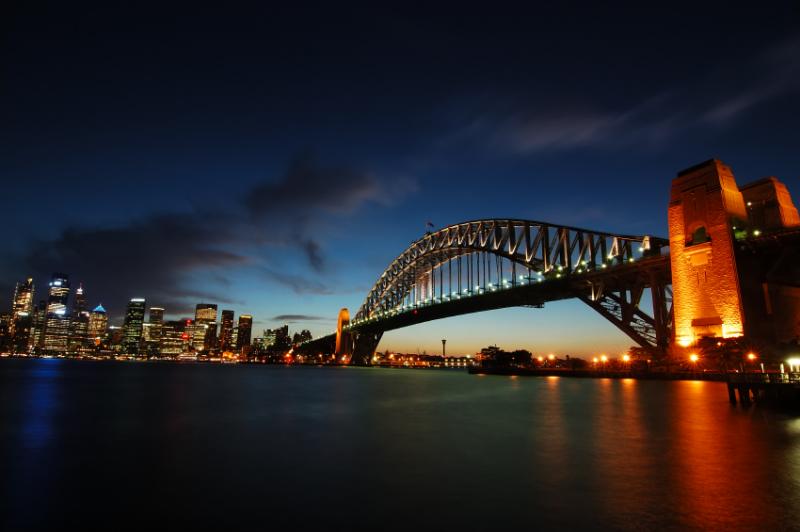Sydney Sightseeing Attractions
The Domain: The area behind Parliament House and Hyde Park Barracks is a park called The Domain. A largely recreational area, and a favourite with lunch-time joggers, it contains the Art Gallery of NSW and includes Mrs Macquarie's Point with fine views of the city, the Harbour Bridge, and the Opera House across the Royal Botanic Gardens. It's also the favourite venue for large, open-air concerts and events like Opera in the Park and Carols by Candlelight.
Sydney Opera House: The Sydney Opera House is possibly Sydney's best-known landmark and international symbol; probably the first Sydney sight or attraction that most visitors will encounter. Click the attraction for more information.
Sydney Harbour Bridge: Sydney's greatest icon - The Sydney Harbour Bridge- took eight years to build and opened in March 1932. Linking the city with North Sydney, it carries eight lanes of road traffic and two railway tracks which form part of the city's rail suburban network.
Town Hall Precinct: The Town Hall Precinct includes Sydney Town Hall, St Andrews Cathedral, and the Queen Victoria Building. Completed in 1819, St Andrews is the oldest cathedral in Australia.
Circular Quay: Circular Quay is both a gateway to the city and the harbour. It was where the first European settlement began. Along the quay you'll find buskers and street masseurs as you enjoy the comings and goings of tourists and locals.
Macquarie Street: Macquarie Street houses several of the most interesting Sydney buildings; the State Library of New South Wales, Parliament House, Sydney Hospital, the Old Mint (now a museum), Hyde Park Barracks and the Land Titles Office.
Bondi Beach: Bondi Beach has featured on more postcards and in more television travel shows and films than any other beach in Australia. It is patrolled in daylight hours by volunteer lifesavers and professional lifeguards. It also has enclosed swimming baths at its southern end if you do not feel like tackling the waves.
Coogee: Nowhere near as expansive as Bondi, Coogee is a great beach for visitors. It has a paved esplanade around the beach with several restaurants and cafes and two popular hotels with accommodation, bars and entertainment. Coogee is a good swimming beach and has swimming baths at both ends.
Double Bay: Double Bay features many of Sydney's exclusive fashion boutiques for men and women and real antique and art shops - no bric-a-brac or cheap copies here. The Cosmopolitan Hotel is a favourite place to be seen in, as are several chic restaurants.
Manly: Manly is at the northern end of Sydney Harbour and has a harbour beach and one of Sydney's longest and most beautiful ocean beaches. The surfing beach at Manly is about three kilometres long and has three names. It is an ideal 'city escape' for visitors who enjoy swimming, surfboarding or windsurfing. Manly also boasts numerous restaurants, cafes and pubs - some with discos.
The Rocks: The Rocks has the biggest concentration of historic buildings in Sydney. Most have been repurposed with house shops, restaurants, art galleries, and the like. The area is dotted with pubs, including the Lord Nelson which has traded since 1842 and the hero of Waterloo since 1845. The 'Hero' was notorious as a source of unwilling crewmen for ships which were short-handed. Men were made drunk and dragged off by 'press gangs' through a tunnel which ran under the hotel to a house across the street from where they were taken to the nearby wharves.
Hyde Park: The biggest patch of green in the city, Hyde Park starts at Queens Square (Hyde Park Barracks) and extends two city blocks to Liverpool Street. It is a pretty walk in daylight and its main attractions are the Archibald fountain at the Queens Square end and the Anzac Memorial at the Liverpool Street end.
Chinatown: Sydney has a large Chinese community, originally made up of Cantonese speakers from southern China who arrived in the 1850s Gold Rush era. Sydney's Chinatown is a bustling enclave of restaurants, shops and supermarkets on the southern fringe of the city area between George Street and Darling Harbour.
Darling Harbour: Darling Harbour houses Sydney's convention and exhibition centres as well as several major tourist attractions, shops, restaurants and cafes. Built around Cockle Bay on the western fringe of the city centre, it starts at the bottom end of Market Street and stretches to Chinatown, where it then does a U-turn and continues around to the other side of the bay.
AMP Tower: The AMP Tower is the tallest structure in Sydney. Sitting above the Centrepoint centre (Market and Castlereagh Streets), it is a steel tower topped with a circular, gold anodised structure housing an observation deck and a revolving restaurant. Offers sweeping views of the entire city and Sydney Harbour, the observation deck is fully enclosed with floor-to-ceiling glass and is equipped with high-power binoculars.
St Mary's Cathedral: In College Street, running along the north-eastern side of the park, is one of the world's largest cathedrals. On the other side of the park is the Great Synagogue; both run free tours.
Parliament House: Nearby Parliament House is the world's oldest continually operating parliament building. The lovely sandstone exterior hides the contemporary interior which has boasts a modern restaurant and swimming facilities to help the politicians in their daily grind. There are free guided tours and the public gallery is open when parliament sits.


